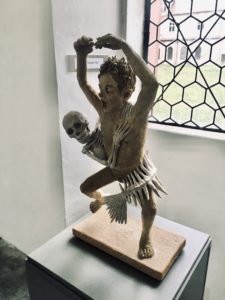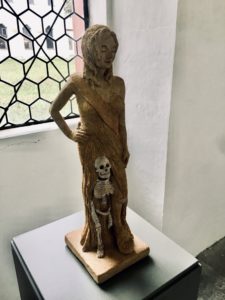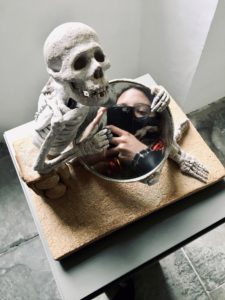News
Death Wears Many Faces – The Exhibition “Totentanz” by Angela Eberhard in Buxheim (Bavaria)
 The exhibition „Totentanz“ by Angela Eberhard draws its lens towards the depiction of the Dance of the Dead and its representation in our society in the 21st century. The key of her work lies in the foreshadowing of the immediacy of death since the ceramic sculptures always embody a skeleton as well as a person on the brink of dying from various causes.
The exhibition „Totentanz“ by Angela Eberhard draws its lens towards the depiction of the Dance of the Dead and its representation in our society in the 21st century. The key of her work lies in the foreshadowing of the immediacy of death since the ceramic sculptures always embody a skeleton as well as a person on the brink of dying from various causes.
Her Dance of the Dead depiction plays on historical narratives such as being tortured with nails until the sweet release of death absolves the sufferer but also addresses taboo topics that have only recently spurred an open conversation in the Western society: from miscarriage to heart attacks, from drowning to infant death, Eberhard has the courage to not shy away from imagining the terrors of death and approaches the subject almost with a strange sense of humour.
Eberhard draws on the first representations of the Dance of the Dead. The first depiction came with the 14th century, in the times where the plague brought a cloud of devastation to the Middle Age era. In this period of time where society slowly worked towards luxuries such as wealth, individuality and power, the inevitability of death and unachievable immortality has become a thought strongly associated with privilege – a privilege to lead a fulfilling life with comfort and dreams, which very much falls into a contemporary conversation of a civilised society.
The first wall painting of the Dance of the Dead came in the 15th century although the inspiration stems from the 11th century legend of the three kings who meet three dead men during their hunting excursion. This Memento Mori is representative of the limitations and the value to the living, which Eberhard explores in the context of today.
 The exhibition is held at the Kartause (a monestary) in Buxheim (Bavaria), giving it the unsettling backdrop that the art works as well as the Halloween season deserve. The sculptures are exhibited in one neat row where each representation of death is framed by the cloister windows to allude towards the thin line between death and the bright purity of heaven.
The exhibition is held at the Kartause (a monestary) in Buxheim (Bavaria), giving it the unsettling backdrop that the art works as well as the Halloween season deserve. The sculptures are exhibited in one neat row where each representation of death is framed by the cloister windows to allude towards the thin line between death and the bright purity of heaven.
The ceramic sculptures capture an organic quality, almost as if the material consists of natural sources such as earth and sand. This evocation resonates with the origin story of the creation of mankind, which directly connects to Hans Christian Andersen who draws our attention to the fact that birth is synonymous with a death sentence:
“Das Leben ist wie die Lampe, die auch schon anfängt auszubrennen, wenn sie angezündet wird! So alt wie jeder von euch ist, so viele Jahre habe ich schon mit euch getanzt. Jeder hat seine eigenen Touren, und der eine hält den Tanz länger aus als der andere. Aber die Lichter verlöschen zur Morgenstunde, und dann sinkt ihr alle müde in meine Arme – das nennt man sterben.”
The main ideas of this sentiment by Andersen is the reflection on the reality that death is with you from the moment you are born, which means that death has been dancing with you for as many years as you are old – a timeless conversation that no person can be exempt from. 
The careful and intricate technique that Eberhard uses as well as her modern interpretation of the Dance of the Dead reinforce how the pairing of century-old, traditional forms of art with a contemporary conversation has the potential to bring innovative work to the art market, which is also reflective of Ernestina Abbühl and her art that we exhibit in the Central Art Gallery.
You can still visit the exhibition in Buxheim until the 1. November 2020. What better way to reflect on this Halloween season with the spooky exploration of the Dance of the Dead and a critical analysis of how Eberhard interprets this traditional representation of our society?
by Léonie Kirchgeorg
